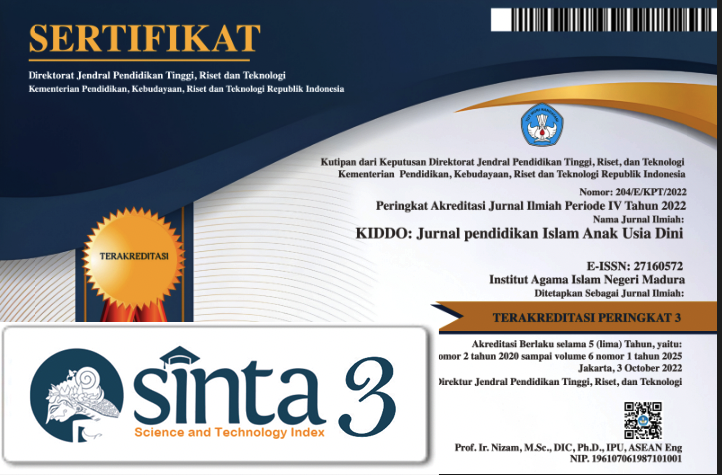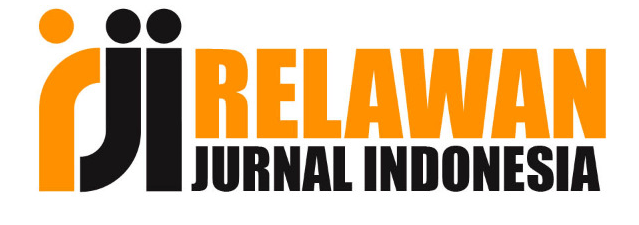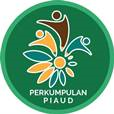The Comparison in Indoor and Outdoor Physical Activity of Locomotor Skill programs in Preschool
 Abstract views: 223
,
Abstract views: 223
,
 PDF downloads: 152
PDF downloads: 152
Abstract
This study aimed to determine how the effect of structured movement session in natural outdoor on the gross motor skill of children, especially activities in the natural outdoor. The focus of the discussion in this study were revealed and analyzed the locomotor skills in children 5 to 6 years old of preschool, and compared of indoor structured play and natural outdoor free play on the locomotor skill of preschool children. The subjects were 2 schools with indoor structured play and another school with natural outdoor free play. Sixty children (35 boys and 25 girls) served as subjects. Data obtained through observation, documentation and then the pefomance a chi-square test was used to data analyze, to determine the difference in a locomotor skill between in an indoor structured play and natural outdoor free play of preschool children. The results of this study showed that there is no significant difference between the locomotor skills of children in indoor structured play or outdoor free play. A t-test score for independent sample was not significant (-2.182 < 0.05)(t = -2.182, df = 58, p = .86), its mean there was no difference in a locomotor skill between in a indoor structured play and natural outdoor free play. This allows for consideration for parents, practitioners, and academics in delivering stimulation and gross motor activities on children.
Downloads
References
ACAR, H. (2014). Learning environments for children in outdoor spaces. Procedia Social and Behavioral Science, 141, 846-853
Kids at play. (2009). Active play everyday. www.kidsatplay.act.gov.au. Accessed 26 October 2017
Aryamanesh, S., & Sayyah, M. (2014). Effect of some selected games on the development of locomotor skills in 4-6 year-old preschool boys. International Journal of Sport Studies, 4(6), 648-652.
Azlina, W., & S. Z.A (2012). A pilot study: the impact of outdoor play spaces on kindergarten children. Procedia Socia and Behavioral Sciences, 38, 275-283
Becker, D. R., McClelland, M. M., Loprinzi, P., & Trost, S. G., et al. (2014). Physical activity, self-regulation, and early academic achievement in preschool children. Early education and development, 25, 56-70
Bento, G., & Dias, G. (2017). The importance of outdoor play for young children’s healthy development. Porto Biomedical Journal, 2(5), 157-160.
Bogdanowicz, J. (1948). Physical development of the child. Warszawa: instytut Wydawniczy
Centers for Disease Control and Prevention, National Center for Chronic Disease Prevention and Health Promotion, Division of Nutrition and Physical Activity. Physical activity for everyone: physical activity terms. Available at: http://www.cdc.gov/nccdphp/dnpa/physical/terms/index.htm. Accessed Desember 1, 2017.
Centers for Disease Control and Prevention. Guidelines for school and community programs to promote lifelong physical activity among young people. MMWR Recomm Rep. 1997;46:1–36.
David, N. (2015). National Soccer Coaches Association of America Complete Soccer Coaching Curriculum for 3-18 years old Players: Vol 1. Westerly: Coaching Media Group.
Deiner, P. L., & Qiu, W. (2007). Embedding physical activity and nutrition in early care and education programs. Zero to Three Journal, 28(1), 13-18.
Deli, E,. Bakle., & Zachopoulou. (2006). Implementing intervention movement programs for kindergarten children. Journal of early childhood research, 4(1), 5-18.
Derri, V., Tsapakidou, A., Zachopoulou, E., & Kioumourtzoglou, E. (2006). Effect of music and movement programme on development of locomotor skills by children 4 to 6 years of age. European Journal of Physical Education, 6, 16-25
Ernst, J. (2014). Early childhood educators’ use of natural outdoor setting as learning environments: an exploratory study of beliefs, practices, and barriers. Environmental Education Research, 20(6), 735-752
Fjørtoft, I. (2001). The natural environment as a playground for children: The impact of outdoor play activities in pre-primary school children. Early Childhood Education Journal, 29(2), 111-117
Gagen, L.M., & Getchell, N. (2006). Using ‘constrait’ to design developmentally appropriate movement activities for early childhood education. Early Childhood Education Journal, https://doi.org/ 10.1007/s10643-006-0135-6
Guinhouya, B.C., Samouda, H., Zitouni, D., Vilhelm, C., & Hubert, H. (2011). Evidence of the influence of physical activity on the metabolic syndrome and/or on insulin resistance in pediatric populations: a systematic review. Int J Pediatr Obes. 6: 361-88.
Haywood, K. M., & Getchell, N. (2009). Lifespan motor development (5th ed.). Champaign, IL: Human Kinetics.
Hinkley, T., Crawford, D., Salmon, J., Okely, A. D., & Hesketh, K. (2008). Preschool children and physical activity: A review of correlates. Am J Prev Med. 34 :435-441
Hunter, J., Graves. C., & Bodensteiner, A. (2017). Adult perspectives on structured vs. unstructured play in early childhood environmental education. The International Journal of Early Childhood Environmental Education. 5(1), 89-92.
Janssen, I. & Leblanc, A.G. (2010). Systematic review of the health benefits of physical activity and fitness in school-aged children and youth. Int J Behav Nutr Phys Act. 7:40.
Kroeker, J. (2017). Indoor and outdoor play in preschool programs. Universal Journal of Education Research, http://doi,org/ 10.13189/ujer.2017.050413.
Laura, M., & Gull, L. G. (2017). Parent’s and early childhood educators’ attitudes and practices in relation to children’s outdoor risky play. Early childhood education journal, Doi:10.1007/s10643-017-0856-8.
Miller, D., K. Tichota., & J, White. (2009). Young children learn through authentic play in a nature explore classroom. Lincoln, NE: Dimensions Foundation
Moore, R. C., & Wong, H. (1997). natural learning: the life history of an environmental schoolyard: creating environments for rediscovering nature’s way of teaching. Berkeley: MIG Communications. pp.65
Murata, N. M., & Maeda, J. K. (2002). Structured play for preschoolers with developmental delays. Early Childhood Education Journal, 29(4), 237-240.
Newell, K. M. (1986). Constraints on the development of coordination. In M. Wade,. & H.T.A. Whiting (Ed.), Motor development in children: Aspects of coordination and control (pp. 341-360). Dordrecht, Germany: Martinus Nijhoff.
Osinski, W. (2003). Anthropomotorics. Poznan:AWF.
Pate, R. R., Pfeiffer, K.A., Trost, S. G., Ziegler, P., & Dowda, M. (2004). Physical activity among children attending preschools. Pediatric. 114: 1258-1263.
Przeweda, R. (1981). Somatic & Motoric Develop. Warszawa: WsiP.
Robinson, L. E., Webster, E. K., Logan, S. W., Lucas, W. A., & Barber, L. T. (2012). Teaching practices thet promote motor skills in early childhood setting. Early Childhood Education Journal, https://doi.org/10. 1007/s10643-011-0496-3
Saavedra, J.M., Escalante, Y., & Garcia-Hermoso A. (2011). Improvement of aerobic fitness in obese children: a meta-analysis. Int J Pediatr Obes, 6: 169-77.
Shoval, E., Sharir, T., & Shulruf, B. (2014). The challenge kindergarten model: integrating body-movement and scaffolding to kepp the child in the center and make systematic progress in learning. Early childhood Education Journal, https://doi.org/10.1007/s10643-013-0609-2
Ulrich, D.A. (2000). Test of gross motor development. Austin: Pro Ed.
Zachopoulou, E,. Tsapakidou, A,. & Derri, V. (2004). The effect of a developmentally appropriate music and movement program on motor performance. Early Childhood Research Quarterly, https://doi.org/10.1016/j.ecresq.2004.10.005
Shoval Ella, Sharir Tal, Arnon Michal, and Tenenbaum Gershon. (2017). The Effect of Integrating Movement into the Learning Environment of Kindergarten Children on their Academic Achievements. Early Childhood Education Journal 46(2). Doi: 10. 1007/s10643-017-0870-x
Stewart , Roger, Audrey Rule, and Debra Giordano. 2007. The effect of fine motor skill activities on kindergarten student attention. Early childhood education journal. 35(2): 103-109. Doi: 10.1007/s10643-007-0169-4
Copyright (c) 2024 Luthfatun Nisa

This work is licensed under a Creative Commons Attribution 4.0 International License.
-
The journal operates an Open Access policy under a Creative Commons 4.0 International license. The terms of the license are:
Share— copy and redistribute the material in any medium or format
Adapt— remix, transform, and build upon the material for any purpose, even commercially.
1. Authors retain copyright and grant the journal right of first publication with the work simultaneously licensed under a Creative Commons License.that allows others to share the work with an acknowledgement of the work’s authorship and initial publication in this journal
2. Authors are permitted and encouraged to post their work online (e.g., in institutional repositories or on their website) prior to and during the submission process, as it can lead to productive exchanges, as well as earlier and greater citation of published work (See The Effect of Open Access).
Jurnal Kiddo is licensed under a Creative Commons
n Access).














